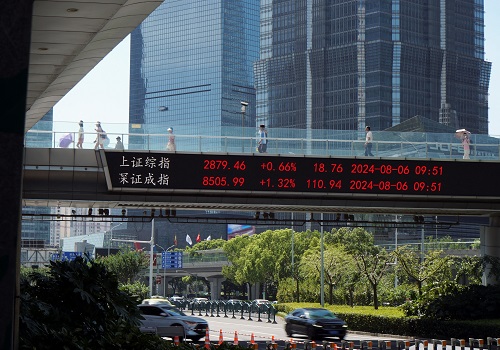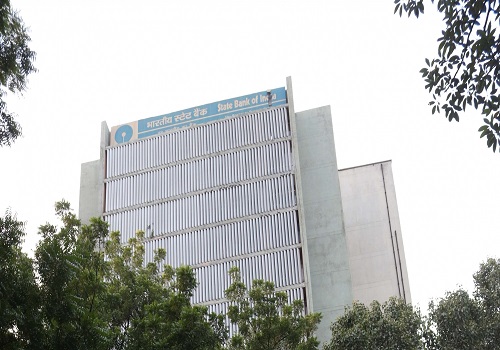Jeera trading range for the day is 24120-24560 - Kedia Advisory

Follow us Now on Telegram ! Get daily 10 - 12 important updates on Business, Finance and Investment. Join our Telegram Channel
Gold
Gold prices rose by 0.48% to settle at Rs.77,531, supported by a weaker dollar and ongoing uncertainty surrounding U.S. President-elect Donald Trump’s tariff policies. Additional upward pressure came from China’s central bank, which expanded its gold reserves for the second consecutive month in December. Market participants are now focusing on U.S. labor data and the Federal Open Market Committee (FOMC) minutes to assess future interest rate trajectories. Comments from Fed Governor Lisa Cook hinted at a cautious monetary policy, emphasizing persistent inflation and a robust labor market, factors that could weigh on gold's appeal as a non-yielding asset. Globally, demand dynamics provided mixed signals. In India, gold discounts remained steady at $14 per ounce as elevated prices deterred buyers. Conversely, Chinese premiums rose to $4.50-$10 per ounce ahead of the Chinese New Year, signaling stronger demand. Other regions such as Hong Kong and Japan saw gold trading in narrower premium-to-discount ranges. Central bank activity continued to bolster the yellow metal, with global net purchases of 53 tonnes in November. The National Bank of Poland led with a 21-tonne addition, followed by the Reserve Bank of India, which added 8 tonnes, bringing its total 2024 purchases to 73 tonnes. Technically, the market witnessed short covering with a 1.69% drop in open interest, settling at 11,608 contracts. Support is now at Rs.77,150, with potential downside to Rs.76,765. Resistance is seen at Rs.77,880, and a breach above this could push prices towards Rs.78,225.
Trading Ideas:
* Gold trading range for the day is 76765-78225.
* Gold climbed supported by a weaker dollar as traders grappled with uncertainty surrounding President-elect Donald Trump’s tariff policies.
* Additional support came from figures from China's central bank, which increased its gold reserves for the second consecutive month in December.
* November gold purchases point to another strong year of central bank demand – World Gold Council
Silver
Silver prices gained 0.35% to settle at Rs.90,873, supported by a weakening U.S. dollar as markets assessed mixed signals regarding U.S. trade policies under President-elect Donald Trump. While reports suggested a more targeted tariff approach, Trump’s denial prompted caution among investors. The focus now shifts to U.S. labor market data and its implications for Federal Reserve policy, which could influence the dollar and, in turn, silver prices. In China, a positive economic outlook bolstered sentiment, with Beijing promising "more proactive" policies and rate cuts to stimulate growth. This is crucial for silver, given its significant industrial applications. The global silver market continues to face a structural deficit, expected to decline by 4% to 182 million ounces in 2024. Total demand is projected to rise by 1%, driven by record industrial usage and recovering jewelry consumption, offsetting a 16% drop in physical investment demand. On the supply side, mine output is forecasted to grow by 1%, led by Mexico, Chile, and the U.S., while recycling is set to rise by 5% due to increased silverware scrap in the West. Technically, the market saw short covering with a 5.33% drop in open interest, settling at 26,581 contracts. Support is now at Rs.90,300, with further downside potential to Rs.89,725. Resistance is anticipated at Rs.91,550, and a move above this could push prices toward Rs.92,225.
Trading Ideas:
* Silver trading range for the day is 89725-92225.
* Silver gains as the US dollar weakened following reports that the incoming Trump administration might adopt a more targeted approach in applying tariffs.
* Fed Governor Lisa Cook reinforced the central bank's cautious approach to rate cuts, citing the labor market's resilience and persistent inflation.
* In the Eurozone, inflation rate rose as expected in December, and traders continued to bet the ECB will continue to cut rates this year.
Crude Oil
Crude oil prices rose by 1.22% to settle at Rs.6,385, driven by mounting concerns over tighter supplies from Russia and Iran amid escalating Western sanctions. These fears have spurred demand for Middle Eastern crude, with Saudi Arabia raising oil prices for Asian markets in February - the first price hike in three months. Further constraining supply, China’s Shandong Port Group banned U.S.-sanctioned oil vessels, while colder weather in the U.S. and Europe has boosted heating oil demand. In the U.S., oil production reached a record 13.46 million barrels per day (bpd) in October, up 260,000 bpd month-over-month, as demand surged to its highest since the pandemic. The Energy Information Administration (EIA) reported a sixth consecutive decline in U.S. crude inventories, which fell by 1.178 million barrels, below expectations of a 2.75 million-barrel draw. However, gasoline and distillate stockpiles rose significantly, with gasoline inventories increasing by 7.717 million barrels and distillates by 6.406 million barrels, far exceeding forecasts. U.S. product supplied for crude oil and petroleum rose by 700,000 bpd to 21.01 million bpd in October, the highest since August 2019. Technically, the market is witnessing short covering as open interest dropped by 3.19% to 11,853 contracts, while prices gained Rs.77. Support is at Rs.6,308, with further downside likely at Rs.6,232. Resistance stands at Rs.6,427, and a break above this level could see prices testing Rs.6,470.
Trading Ideas:
* Crudeoil trading range for the day is 6232-6470.
* Crude oil rose on concerns over tighter Russian and Iranian oil supply due to escalating Western sanctions.
* Concerns over supply tightness drove increased demand for Middle Eastern oil
* Shandong Port Group ban US-sanctioned oil vessels from its ports is set to put pressure on supply in China.
Natural Gas
Natural gas prices fell by 3.22% to close at Rs.300.6, pressured by forecasts of reduced heating demand and smaller-than-expected output reductions from freezing wells. Severe cold in the eastern U.S. lowered daily gas supply to a six-week low of 102.6 billion cubic feet (Bcf), but freeze-off production declines were milder than in past years, with average January output at 105 Bcf/day, near record highs. Gas flows to LNG export plants increased to 15.1 Bcf/day in January, reflecting sustained global demand due to Europe’s reduced reliance on Russian pipeline supplies. Meteorologists predict colder-than-normal weather across the U.S. through January 21, potentially increasing demand further. Current forecasts indicate gas use in the Lower 48 states could rise from 146.2 Bcf/day this week to 148.8 Bcf/day next week, with a daily peak of 155.8 Bcf projected on January 14. U.S. utilities withdrew 116 Bcf of gas from storage for the week ending December 27, below expectations of 127 Bcf, reducing total stockpiles to 3,414 Bcf and narrowing the surplus over the five-year average to 4.7%.The EIA projects U.S. natural gas production to decline in 2024 to 103.2 Bcf/day from 2023's record of 103.8 Bcf/day, while domestic consumption is expected to rise to a record 90.5 Bcf/day. Technically, natural gas saw fresh selling with a 25.97% rise in open interest to 13,388 contracts, while prices fell by Rs.10. Support is at Rs.291.7, with a potential test of Rs.282.8, while resistance is at Rs.315.5, and a move above could see prices testing Rs.330.4.
Trading Ideas:
* Naturalgas trading range for the day is 282.8-330.4.
* Natural gas fell on forecasts for less heating demand than previously expected.
* Average gas output in the Lower 48 U.S. states has slid to 103.3 bcfd so far in January, down from 103.8 bcfd in December.
* LSEG projected total gas use could reach 155.8 bcfd on Jan. 14, which would fall well short of the daily record of 168.4 bcfd on Jan. 16, 2024.
Copper
Copper prices rose by 0.5% to close at Rs.816.65, supported by optimism surrounding China's economic recovery. Beijing’s pledge to adopt "more proactive" macroeconomic policies and lower interest rates in 2024 buoyed sentiment. The rally also benefited from a weaker U.S. dollar, driven by speculation of a softer U.S. trade policy, though caution returned after denials by U.S. President-elect Donald Trump. In production data, Chile’s copper production reached 488,519 metric tons in November, up 9.8% YoY, while Codelco reported a slight annual increase of 3,000-4,000 metric tons. China’s copper cathode output rose by 0.94% MoM in November, exceeding expectations by 24,200 metric tons. Meanwhile, imports of unwrought copper in China surged to a one-year high of 528,000 tons in November, a 4.3% increase from October, amid restocking and lower domestic inventories. However, imports of copper concentrate fell by 7.8% YoY in November. On the global front, the refined copper market posted a 41,000 metric tons deficit in October, improving from September’s 136,000 metric tons deficit, according to the ICSG. For the first 10 months of 2024, the market held a surplus of 287,000 metric tons. Technically, copper is under short covering as open interest fell by 3.54% to 6,764 contracts, while prices increased by Rs.4.1. Immediate support lies at Rs.811.6, with a potential test of Rs.806.5, while resistance is pegged at Rs.820.5, and a breakout above could drive prices toward Rs.824.3.
Trading Ideas:
* Copper trading range for the day is 806.5-824.3.
* Copper prices received support from an improving economic outlook in China.
* Beijing recently pledged to implement "more proactive" macroeconomic policies and lower interest rates this year to boost growth.
* Investors are focusing on key US labor market data this week to assess the outlook for Federal Reserve monetary policy.
Zinc
Zinc prices edged lower by 0.02% to close at Rs.273.9, as concerns over weakening demand in China weighed on market sentiment. China's slower-than-expected factory activity growth in December, coupled with falling export orders, further highlighted ongoing demand challenges. However, hopes that the incoming U.S. administration may adopt less aggressive tariff policies helped limit the downside. Inventories in Shanghai Futures Exchange warehouses dropped by 20.9% from last Friday, reflecting tighter supplies. In November 2024, China’s refined zinc production increased marginally by over 1,000 metric tons (0.3% MoM) but remained 12% lower YoY, exceeding initial expectations. Cumulatively, domestic refined zinc production from January to November totaled over 5.6 million metric tons, down nearly 6% YoY. Production gains in regions like Qinghai, Inner Mongolia, and Hunan offset lower-than-expected output in Henan and Gansu. On the global front, the zinc market deficit widened to 69,100 metric tons in October from 47,000 metric tons in September, according to the ILZSG. Despite this, a surplus of 19,000 metric tons persisted in the first 10 months of 2024 due to refined production falling 1.7% and zinc mine output declining 3.8%.Technically, zinc witnessed fresh selling with an 8.67% rise in open interest to 3,624 contracts as prices fell by ?0.05. Immediate support is at Rs.272.6, with further testing at Rs.271.3, while resistance is seen at Rs.275.3, with a move above potentially testing Rs.276.7.
Trading Ideas:
* Zinc trading range for the day is 271.3-276.7.
* Zinc prices dropped amid concerns about demand in China.
* However, downside limited amid hopes that President-elect Donald Trump's proposed tariffs would be less aggressive than promised.
* In December 2024, domestic refined zinc production will increase by over 20,000 mt MoM or about 5% MoM
Aluminium
Aluminium prices rose by 0.82% to Rs.240.35, driven by worries over tightening supplies on the London Metal Exchange (LME). The cash-to-three-month contract discount narrowed to $19 per ton, down from over $40 in December, reflecting increased supply concerns. LME-registered aluminium stocks fell by over 40% since May 2024 to 634,650 tons, with 54% of these stocks earmarked for delivery, indicating further withdrawals from warehouses. Global aluminium production and consumption data highlight a tightening market. In October, the refined aluminium market faced a 40,300-ton deficit, with global production at 6.0856 million tons and consumption at 6.1259 million tons. Cumulative data for the first ten months of 2024 revealed a supply shortage of 332,600 tons, with production totaling 59.65 million tons and consumption reaching 59.99 million tons. Meanwhile, China's aluminium output increased by 3.6% YoY in November to 3.71 million tons, and daily production averaged 123,667 tons. Year-to-date production in China rose by 4.6% YoY to 40.22 million tons, supported by capacity expansions despite declining industry profits. On the export front, China's unwrought aluminium and aluminium product shipments grew 17% YoY to nearly 5.5 million tons in the first ten months of 2024. Technically, the aluminium market witnessed short covering, with a 7.67% drop in open interest to 3,432 contracts as prices gained Rs.1.95. Support is at Rs.238.7, with further downside testing at Rs.237. Resistance is seen at Rs.241.3, and a move above could test Rs.242.2.
Trading Ideas:
* Aluminium trading range for the day is 237-242.2.
* Aluminium gains on worries about supplies on the LME market.
* The discount for the cash contract over three-month aluminium narrowed to around $19 a ton from more than $40 in December.
* Global primary aluminium output in November rose 3% year on year to 6.04 million tonnes
Cottoncandy
Cottoncandy prices rose marginally by 0.09% to Rs.54,880, supported by increased cotton yarn demand in South India from garment industries and strong export orders. However, arrivals in North India, particularly in Punjab, Haryana, and Rajasthan, fell by 43% compared to the same period last year, creating supply chain challenges. Farmers are holding back kapas in anticipation of higher prices, causing raw material shortages for ginners and spinners, especially in Punjab. Globally, cotton production for the 2024-25 cotton year is projected to increase by 1.2 million bales to 117.4 million, driven by higher output in India, Argentina, and other countries. India’s cotton imports are estimated at 25 lakh bales for 2024-25, significantly higher than the previous season’s 15.20 lakh bales. U.S. cotton production is revised higher to 14.3 million bales, while global consumption is raised by 570,000 bales, led by increases in India, Pakistan, and Vietnam, offsetting a decline in China. World trade projections show slight growth due to increased exports from Brazil, Benin, Cameroon, and Senegal. Technically, the cottoncandy market is experiencing fresh buying, with open interest increasing by 5.5% to 422 contracts. Prices gained Rs.50, with immediate support at Rs.54,730 and potential downside to Rs.54,590. Resistance is observed at Rs.54,980, and a move above this level could test Rs.55,090.
Trading Ideas:
* Cottoncandy trading range for the day is 54590-55090.
* Cotton gains as cotton yarn prices increased due to rising demand from garment industries and strong export orders.
* India's cotton production in 2024/25 is likely to fall by 7.4% from a year ago
* Cotton production is projected to increase in China, Brazil, and Argentina, more than offsetting reductions in the US and Spain – USDA
* In Rajkot, a major spot market, the price ended at 25908.5 Rupees dropped by -0.18 percent.
Turmeric
Turmeric futures rose 0.35% to close at Rs.15,590, supported by strong buying activity and reports of limited supplies ahead of the new crop arrival. Market arrivals increased to 9,030 bags compared to 7,965 bags in the previous session. However, the downside remains limited as the turmeric crop is in good to excellent condition with minimal weather disruptions. Delays in harvesting, caused by prolonged vegetation growth due to extended rains, may push fresh supplies' timelines. On the production front, turmeric sowing in key regions like Maharashtra, Telangana, and Andhra Pradesh is estimated to have increased by 30-35% compared to last year. Nationwide, sowing is projected to rise to 3.75-4 lakh hectares, up from 3-3.25 lakh hectares in 2023. Despite higher acreage, last year's unfavorable weather limited production to 45-50 lakh bags, coupled with an outstanding stock of 35-38 lakh bags. Exports during April-October 2024 grew by 6.57% to 108,879.96 tonnes compared to the same period in 2023. October exports rose 57.22% year-on-year to 15,938.21 tonnes. Conversely, imports surged 118.99% year-on-year to 17,692.28 tonnes during April-October 2024. In October alone, imports rose 16.90% month-on-month but dropped 23.53% year-on-year to 1,950.16 tonnes. Technically, turmeric is witnessing fresh buying, with open interest increasing by 0.48% to 12,460 contracts. Immediate support lies at Rs.15,410, and a break below could test Rs.15,230. Resistance is at Rs.15,720, and a move above may push prices towards Rs.15,850, keeping market sentiment cautiously optimistic.
Trading Ideas:
* Turmeric trading range for the day is 15230-15850.
* Turmeric gains on strong buying activity amid reports of low supplies till the arrival of new crop.
* However downside seen limited as turmeric crop is reported to be in good to excellent condition.
* In Indonesia, dry weather has accelerated harvesting, which is currently at peak levels.
* In Nizamabad, a major spot market, the price ended at 14354 Rupees dropped by -0.15 percent.
Jeera
Jeera futures settled 0.51% lower at Rs.24,325, driven by profit booking after recent gains. Prices had surged earlier due to delayed sowing in Gujarat and Rajasthan, the major producing states, caused by higher temperatures impacting germination. India's cumin production reached 8.6 lakh tonnes from 11.87 lakh hectares in 2023-24, compared to 5.77 lakh tonnes from 9.37 lakh hectares the previous year. However, current estimates suggest a 10% decline in production, with Rajasthan expected to see a 10-15% reduction in cultivation. Despite this, strong domestic and export demand is providing support. Jeera exports during April-October 2024 jumped 77.37% year-on-year to 135,450.64 tonnes, with October exports surging 161.04% year-on-year to 16,257.44 tonnes. Global demand remains robust, particularly from China and Europe, as Indian cumin is currently the cheapest globally at $3,050 per tonne, significantly lower than Chinese cumin prices. Geopolitical tensions in the Middle East have further boosted demand for Indian cumin. Technically, the market is witnessing long liquidation, with open interest dropping by 16.78% to 1,116 contracts. Immediate support lies at Rs.24,230, with a breach potentially testing Rs.24,120. Resistance is at Rs.24,450, and a move above this level could push prices to Rs.24,560, reflecting cautious optimism.
Trading Ideas:
* Jeera trading range for the day is 24120-24560.
* Jeera dropped on profit booking after prices gained as sowing has been delayed
* Higher day temperatures in the past few weeks has impacted the seeding of jeera and has also led to poor germination in various places.
* Jeera exports during Apr-Oct 2024, rose by 77.37 percent at 135,450.64 tonnes as compared to Apr-Oct 2023.
* In Unjha, a major spot market, the price ended at 24251.15 Rupees dropped by -0.58 percent.
Views express by all participants are for information & academic purpose only. Kindly read disclaimer before referring below views























